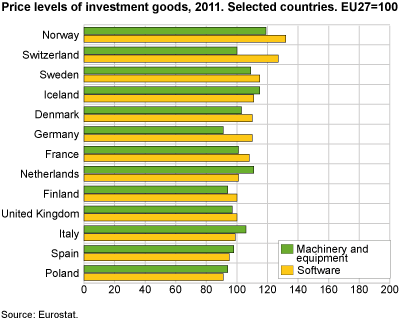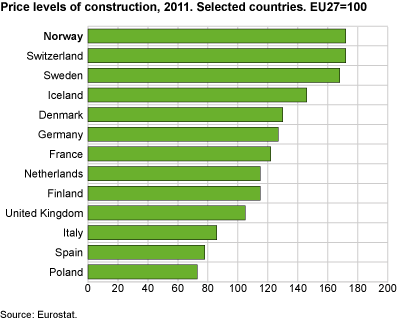Content
Published:
This is an archived release.
High investment prices in Norway and Switzerland
Businesses in Norway and Switzerland are faced with Europe’s highest price levels for both investment goods and construction projects. While the price levels for investment goods are relatively homogenous across Europe, there are substantial differences for construction.
These are among the conclusions that can be drawn from a survey published earlier this month by Eurostat, the Statistical Office of the European Commission. The survey was carried out in the framework of the 2011 round of the European Comparison Programme.
In 2011, Norway’s overall price level for gross fixed capital formation was 53 per cent higher than the average for the 27 EU Member States. Compared to the other Nordic countries, Norway’s price level was 13 per cent higher than Sweden’s, 32 per cent higher than Denmark’s, and 35 per cent higher than Finland’s price level. However, for the two main components of gross fixed capital formation, i.e. investment goods and construction, the picture is very different.
Investment goods: a common European price level?
Investment goods include various types of machinery and equipment, as well as software. For these product groups, price levels are remarkably homogeneous across Europe, even though Norway and Switzerland stand out slightly with price levels around 30 per cent above the EU average. However, for 31 out of 37 countries, price levels deviate by less than 10 per cent (plus or minus) from that average.
Price levels are similarly homogeneous for all the four sub-categories of investment goods (metal products and equipment, electrical and optical equipment, transport equipment and software). One reason for this may be that many of these products are traded globally, and that prices are therefore rather less influenced by the level of cost in the importing countries.
Norway and the other Nordic countries, along with Switzerland, are among the most expensive countries in most sub-categories of investment goods. For software, remarkably, Slovakia and Norway have the highest price levels, followed by Sweden and Italy.
Construction: major price level differences
For construction projects, a different picture emerges, even though Norway and Switzerland also have the highest price levels in this sub-category. In those two countries, the price level of construction is 72 per cent higher than in the EU as a whole. Sweden and, to some extent, Iceland also stand out with high price levels, while large EU Member States like Germany and France are about 25 per cent above the EU average. In the United Kingdom, prices are marginally higher than the average.
Unlike investment goods, construction prices differ significantly across countries. For example, the price level of construction is more than four times higher in Norway than in some of the cheaper countries in south-eastern Europe. This reflects differences in countries’ overall price levels, and to some extent corresponds to the price levels for consumer goods and services .
For both residential and non-residential buildings, the highest construction costs are found in Norway, Switzerland, Sweden and Iceland. However, for civil engineering works (mainly investments in infrastructure), the United Kingdom and France are also among the most expensive countries.
About this surveyGross fixed capital formation includes three main sub-groups: machinery and equipment, construction and other investment goods. In this article, the term “investment goods” refers to the sub-groups machinery and equipment and software. Machinery and equipmentMetal products and equipment (e.g. metal products, engines and turbines, pumps and compressors, industrial machinery, production machinery, machinery for agriculture and forestry) Electrical and optical equipment (e.g. office machinery, IT equipment, electrical machinery, communication equipment, medical equipment, optical equipment) Transport equipment (e.g. vehicles for road, rail, sea and air transport) ConstructionResidential buildings (e.g. detached and semi-detached houses, multi-dwelling houses) Non-residential buildings (e.g. factory buildings, office buildings, shopping centres and parking garages) Civil engineering works (e.g. roads, bridges, tunnels and pipelines) Other investment goodsProducts of agriculture, forestry, fisheries and aquaculture Software |
|
Survey prices for investment goods and software include non-refundable VAT and delivery and assembly costs. For construction projects, prices include profit margins, architects and engineers’ fees and VAT. |
For further details, see Eurostat’s Statistics in Focus .
Tables:
The statistics is now published as Comparison of price levels in Europe.
Contact
-
Statistics Norway's Information Centre
E-mail: informasjon@ssb.no
tel.: (+47) 21 09 46 42


